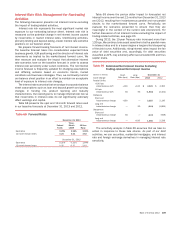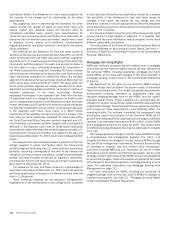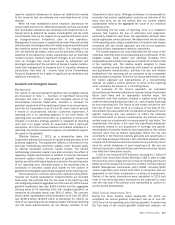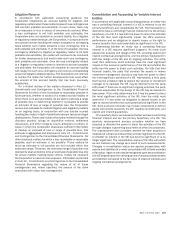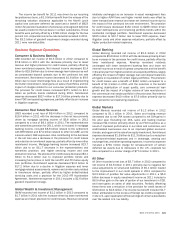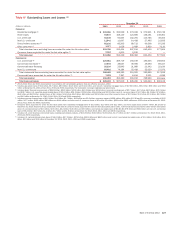Bank of America 2013 Annual Report Download - page 119
Download and view the complete annual report
Please find page 119 of the 2013 Bank of America annual report below. You can navigate through the pages in the report by either clicking on the pages listed below, or by using the keyword search tool below to find specific information within the annual report.Bank of America 2013 117
need for valuation allowances to reduce net deferred tax assets
to the amounts that we estimate are more-likely-than-not to be
realized.
While we have established some valuation allowances for
certain state and non-U.S. deferred tax assets, we have concluded
that no valuation allowance was necessary with respect to all U.S.
federal and U.K. deferred tax assets, including NOL and tax credit
carryforwards, that are not subject to any special limitations (such
as change-in-control limitations) prior to any expiration.
Management’s conclusion is supported by recent financial results
and forecasts, the reorganization of certain business activities and
the indefinite period to carry forward NOLs. The majority of our
U.K. net deferred tax assets, which consist primarily of NOLs, are
expected to be realized by certain subsidiaries over an extended
number of years. However, significant changes to our estimates,
such as changes that would be caused by substantial and
prolonged worsening of the condition of Europe’s capital markets,
could lead management to reassess its U.K. valuation allowance
conclusions. See Note 19 – Income Taxes to the Consolidated
Financial Statements for a table of significant tax attributes and
additional information.
Goodwill and Intangible Assets
Background
The nature of and accounting for goodwill and intangible assets
are discussed in Note 1 – Summary of Significant Accounting
Principles and Note 8 – Goodwill and Intangible Assets to the
Consolidated Financial Statements. Goodwill is reviewed for
potential impairment at the reporting unit level on an annual basis,
which for the Corporation is as of June 30, and in interim periods
if events or circumstances indicate a potential impairment. A
reporting unit is an operating segment or one level below. As
reporting units are determined after an acquisition or evolve with
changes in business strategy, goodwill is assigned to reporting
units and it no longer retains its association with a particular
acquisition. All of the revenue streams and related activities of a
reporting unit, whether acquired or organic, are available to support
the value of the goodwill.
Effective January 1, 2013, on a prospective basis, the
Corporation adjusted the amount of capital being allocated to the
business segments. The adjustment reflects a refinement to the
prior-year methodology (economic capital), which focused solely
on internal risk-based economic capital models. The refined
methodology (allocated capital) now also considers the effect of
regulatory capital requirements in addition to internal risk-based
economic capital models. For purposes of goodwill impairment
testing, we utilized allocated equity as a proxy for the carrying value
of our reporting units. Allocated equity in the reporting units is
comprised of allocated capital plus capital for the portion of
goodwill and intangibles specifically assigned to the reporting unit.
The Corporation’s common stock price improved during 2013;
however, our market capitalization remained below our recorded
book value. We estimate that the fair value of all reporting units
with assigned goodwill in aggregate as of the June 30, 2013 annual
goodwill impairment test was $290.9 billion and the aggregate
carrying value of all reporting units with assigned goodwill, as
measured by allocated equity, was $163.5 billion. The common
stock market capitalization of the Corporation as of June 30, 2013
was $138.2 billion ($164.9 billion at December 31, 2013). As
none of our reporting units are publicly traded, individual reporting
unit fair value determinations do not directly correlate to the
Corporation’s stock price. Although we believe it is reasonable to
conclude that market capitalization could be an indicator of fair
value over time, we do not believe that our current market
capitalization reflects the aggregate fair value of our individual
reporting units.
Estimating the fair value of reporting units is a subjective
process that involves the use of estimates and judgments,
particularly related to cash flows, the appropriate discount rates
and an applicable control premium. We determined the fair values
of the reporting units using a combination of valuation techniques
consistent with the market approach and the income approach
and also utilized independent valuation specialists.
The market approach we used estimates the fair value of the
individual reporting units by incorporating any combination of the
tangible capital, book capital and earnings multiples from
comparable publicly-traded companies in industries similar to that
of the reporting unit. The relative weight assigned to these
multiples varies among the reporting units based on qualitative
and quantitative characteristics, primarily the size and relative
profitability of the reporting unit as compared to the comparable
publicly-traded companies. Since the fair values determined under
the market approach are representative of a noncontrolling
interest, we added a control premium to arrive at the reporting
units’ estimated fair values on a controlling basis.
For purposes of the income approach, we calculated
discounted cash flows by taking the net present value of estimated
future cash flows and an appropriate terminal value. Our
discounted cash flow analysis employs a capital asset pricing
model in estimating the discount rate (i.e., cost of equity financing)
for each reporting unit. The inputs to this model include the risk-
free rate of return, beta, which is a measure of the level of non-
diversifiable risk associated with comparable companies for each
specific reporting unit, size premium to reflect the historical
incremental return on stocks, market equity risk premium and in
certain cases an unsystematic (company-specific) risk factor. The
unsystematic risk factor is the input that specifically addresses
uncertainty related to our projections of earnings and growth,
including the uncertainty related to loss expectations. We utilized
discount rates that we believe adequately reflect the risk and
uncertainty in the financial markets generally and specifically in
our internally developed forecasts. We estimated expected rates
of equity returns based on historical market returns and risk/return
rates for similar industries of each reporting unit. We use our
internal forecasts to estimate future cash flows and actual results
may differ from forecasted results.
In 2013, the consumer DFS business, including $1.7 billion of
goodwill, was moved from Global Banking to CBB in order to align
this business more closely with our consumer lending activity and
better serve the needs of our customers. In 2012, the International
Wealth Management businesses within GWIM, including $230
million of goodwill, were moved to All Other in connection with our
agreement to sell these businesses in a series of transactions.
Certain of the sales transactions were completed in 2013 and
most of the remaining sales transactions are expected to close
over the next year. Prior periods were reclassified to conform to
current period presentation.
2013 Annual Impairment Test
During the three months ended September 30, 2013, we
completed our annual goodwill impairment test as of June 30,
2013 for all of our reporting units that had goodwill. In performing
the first step of the annual goodwill impairment analysis, we




